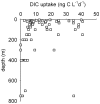Major role of microbes in carbon fluxes during Austral winter in the Southern Drake Passage
- PMID: 19759822
- PMCID: PMC2736376
- DOI: 10.1371/journal.pone.0006941
Major role of microbes in carbon fluxes during Austral winter in the Southern Drake Passage
Abstract
Carbon cycling in Southern Ocean is a major issue in climate change, hence the need to understand the role of biota in the regulation of carbon fixation and cycling. Southern Ocean is a heterogeneous system, characterized by a strong seasonality, due to long dark winter. Yet, currently little is known about biogeochemical dynamics during this season, particularly in the deeper part of the ocean. We studied bacterial communities and processes in summer and winter cruises in the southern Drake Passage. Here we show that in winter, when the primary production is greatly reduced, Bacteria and Archaea become the major producers of biogenic particles, at the expense of dissolved organic carbon drawdown. Heterotrophic production and chemoautotrophic CO(2) fixation rates were substantial, also in deep water, and bacterial populations were controlled by protists and viruses. A dynamic food web is also consistent with the observed temporal and spatial variations in archaeal and bacterial communities that might exploit various niches. Thus, Southern Ocean microbial loop may substantially maintain a wintertime food web and system respiration at the expense of summer produced DOC as well as regenerate nutrients and iron. Our findings have important implications for Southern Ocean ecosystem functioning and carbon cycle and its manipulation by iron enrichment to achieve net sequestration of atmospheric CO(2).
Conflict of interest statement
Figures






References
-
- Denman KL, Brasseur G, Chidthaisong A, Ciais P, Cox PM, et al. Couplings Between Changes in the Climate System and Biogeochemistry. In: Solomon S, Qin D, Manning M, Chen Z, Marquis M, et al., editors. Climate Change 2007: The Physical Science Basis. Contribution of Working Group I to the Fourth Assessment Report of the Intergovernmental Panel on Climate Change. 499-588. Cambridge, United Kingdom and New York, NY, USA: Cambridge University Press; 2007.
-
- Boyd PW, Jickells T, Law CS, Blain S, Boyle EA, et al. Mesoscale Iron Enrichment Experiments 1993–2005: Synthesis and Future Directions. Science. 2007;315:612–617. - PubMed
-
- Blain S, Quéguiner B, Armand L, Belviso S, Bombled B, et al. Effect of natural iron fertilization on carbon sequestration in the Southern Ocean. Nature. 2007;446:1070–1074. - PubMed
-
- Hopkinson BM, Mitchell BG, Reynolds RA, Wang H, Selph KE, et al. Iron limitation across chlorophyll gradients in the southern Drake Passage: Phytoplankton responses to iron addition and photosynthetic indicators of iron stress. Limnol Oceanogr. 2007;52:2540–2554.
-
- Buesseler KO, Doney SC, Karl DM, Boyd PW, Caldeira K, et al. Ocean Iron Fertilization—Moving Forward in a Sea of Uncertainty. Science. 2008;319:162. - PubMed
Publication types
MeSH terms
Substances
LinkOut - more resources
Full Text Sources

